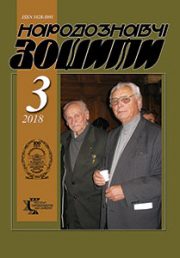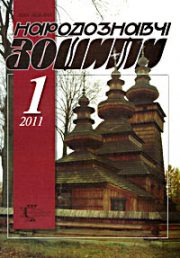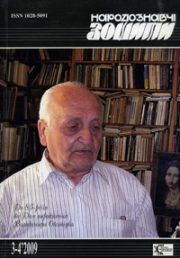The Ethnology Notebooks. 2023. № 2 (170), 379—385
UDK745.51:008(477.83/.86)
DOI https://doi.org/10.15407/nz2023.02.379
ART AS AN ARTISTIC AND AESTHETIC PHENOMENON OF THE SACRED CULTURE OF UKRAINIANS IN GALICIA
ODREKHIVSKYI Roman
- ORCID ID: https://orcid.org/0000-0003-3581-4103
- Dr. hab. in Art Studies, Professor,
- Ivan Boberskyi Lviv State University of Physical Culture,
- Department of Choreography and Art History,
- 11, Kostyushka Str., 79007, Lviv, Ukraine,
- Contacts: е-mail: odre2010@ukr.net
Abstract. Introduction. Art played an important role in the sacred culture of Ukrainians in Galicia and is interpreted in our study in the sense of understanding the works performed for the religious cult of Ukrainians in Galicia. The art of Ukrainians gave the religious cult a national basis.
Problem Statement. Symbolism in sacred art has its national basis. His is demonstrated in many works of sacred art. We are convinced that in the absence of Ukrainian statehood, the plot images of the royal gates affirmed the national authenticity, religious culture and spirituality of Ukrainians. Purpose. Nowhere in the world has the philosophy of the Christian symbolism acquired such importance in ornamentation as in the iconostasis of Ukrainian churches. The iconographic repertoire of sacred carving, as well as painting, played a very important cultural, informational and cognitive value.
The main methods are structural-logical, art-historical methods of pictorial-stylistic, iconographic analysis.
Results. In fact, the interpretation of the invariance of sacred culture was also one of the ideological foundations of the work of folk sacred carving masters in Galicia, thanks to which their traditions reached the beginning of the twentieth century and presented the masterpieces of Ukrainian style to the world. The peculiarities of the national style consisted in the use of ornaments with a national traditional basis. This also applies to the plot itself, and sometimes to the style of the image.
Conclusion. The art of sacred culture played an important religious and aesthetic function in the national and cultural identification of Ukrainians in Galicia and occupied a high status in the national culture of Ukraine and in the architecture of its cultural space.
Keyworlds: philosophy of art, sacred culture, Christianity, church, iconostasis in particular, plastic arts.
Received 6.03.2023
REFERENCE
- Shherbakivsjkyj, V. (1995). Ukrainian art (Selected unpublished works). Kyiv: Lybidj [in Ukrainian].
- Odrekhivskyi, R. (2022). The philosophical background in the artistic works of the church masters in Galicia (end of the 19th — the first third of the 20th century). The Ethnology notebooks, 1, 31—35. DOI: https://doi.org/10.15407/nz2022.01.031 [in Ukrainian].
- Khoma, I. (1995). Essay on the history of the Ecumenical Church. Lviv: Stream [in Ukrainian].
- Lychkovakh, V. (2018). Semiotics of ukrainian and polish waggard in the light of the ideas of the lvvivsk-warsaw philosophical school. Visnyk natsional’noi akademii kerivnykh kadriv kul’turyi mystetstv, 2, 25—31 [in Ukrainian].
- Kryp’jakevych, I. (1990). History of Ukraine. Lviv: Svit [in Ukrainian].
- Melnychuk, O. (Ed.). (1977). Dictionary of foreign words. Kyiv: Holovna redakcija URE [in Ukrainian].
- Phenomenology and hermeneutics. Retrieved from: http://helpiks.org/4-107288.html Date of application 09.10.2020 [in Ukrainian].
- Jaremenko, Vasyl’, & Slipushko, Oksana (Eds.). (2000). New explanatory dictionary of the Ukrainian language: in 4 vol. Kyiv: Akonit [in Ukrainian].
- Kubiyovych, V. (Ed.). Encyclopedia of Ukrainian Studies: words. part: in 11 vol. (1993—2003). Revision in Ukraine. Lviv [in Ukrainian].
- Fedoriv, Ju. (1976). Explanation of church services and Holy Mysteries. Toronto [in Ukrainian].
- Koshetar, U.P. (2005). Ukrainian Greek Catholic Church in the socio-political life of Galicia (1900—1939): initial manual. Kyiv: MAUP [in Ukrainian].
- Tymkiv, B.M. (2012). Art of Ukraine and the Diaspora: sacred and applied woodcarving. Ivano-Frankivsk: Nova Zorja [in Ukrainian].
- Katrij, Ju. (1982). Know your rite! Nju-Jork; Rym: Vydavnyctvo oo. Vasylijan [in Ukrainian].






